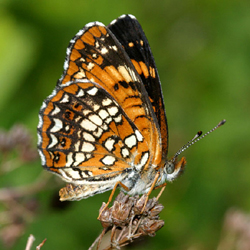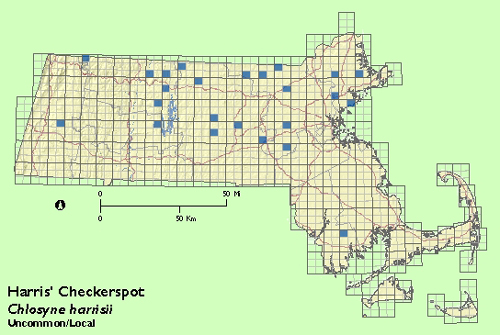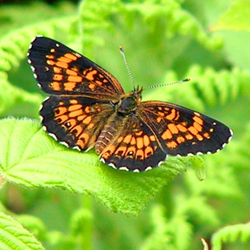Find a Butterfly
Harris' Checkerspot
Chlosyne harrisii
Named
Scudder, 1864

Identification
Wingspan: 1 1/4 ‑ 1 3/4". The Harris‘ Checkerspot is one of five Massachusetts butterflies of roughly similar size, color, and habitat. Above, it is rich orange with wide black borders; this combination readily separates it from the predominantly orange Silver‑bordered and Meadow Fritillaries, with which the Harris‘ is sometimes found. Its closest look‑alikes, the rare Silvery Checkerspot, and the smaller Pearl Crescent, lack the Harris‘ heavy black network pattern on the underwings that sets off the orange and white creating its characteristic checkered effect. See the other species for additional distinctions.
Distribution
Southeastern Saskatchewan and Manitoba east to the Gaspe Peninsula and Nova Scotia; south to North Dakota, the Great Lakes states, and New Jersey. Isolated records occur from the mountains of West Virginia and Georgia. The species occurs throughout New England.
Status in Massachusetts
Uncommon and local throughout most of the Commonwealth; apparently absent from Cape Cod and the Islands. The status seems essentially unchanged since Scudder‘s day. During the Atlas period, twenty‑four records were collected for this species, ranging from sea level to 2000‘ elevation. Central Massachusetts accounted for the majority of specimens. Meadow colonies average 5‑20 butterflies. Maximum: 200 at Holden (Worcester Co.),18 June 1995.

Flight Period in Massachusetts
Typically early June to early July. Extreme dates: 1 June 1991, Worcester (Worcester Co.), T. Dodd and 15 July.
Larval Food Plants
Exclusively Flat‑topped Aster (Aster umbellatus), a fairly common and widespread plant of open, especially wetland, habitats.
Adult Food sources
Harris‘ Checkerspots will nectar on a variety of meadow plants in bloom during their flight period. Found at 8 flowering species during Atlas period, including Arrowwood, Spreading Dogbane, Gray‑stemmed Dogwood and Orange Hawkweed.

Habitat
Wet meadows, swales, powerline clearings, road edges, stream banks, and other open areas where Flat‑topped Aster grows. The species is seldom found far from its larval food plant.
Life Cycle
u>EGG: Bright lemon yellow; dome‑shaped, but concave at the apex. OVIPOSITION: An average of 200 eggs are deposited on the underside of a middle stem leaf of the host plant. Eggs are laid in tiered, two‑ and three‑layered clusters. More than one egg mass per female, deposited on separate plants, is normal. Eggs hatch within five to ten days. LARVA: Orange, with black transverse bands; branched spines; black head. Caterpillars devour their natal leaf within three days, then move to the apex of their plant to continue eating, creating a communal, web-like structure enclosing three to ten leaves. As they continue feeding, they extend the web downward and involve more of the plant. Larvae pass through three instars in this manner, feeding until mid-August. By late August/early September, larvae disappear from their webs, to overwinter in the leaf litter near their host plant. They emerge the following year, usually in mid-May, and feed upon the shoots of their perennial food plant, without the protection of a web. The numbers of second year larvae are markedly reduced and caterpillars are often seen feeding individually or in small groups. They wander frequently from plant to plant at this stage. CHRYSALIS: White, with orange tubercles and black markings. PUPATION: Overwintered larvae pupate in late May and early June. OVERWINTERING STAGE: Late instar larva.
Notes
The life cycle of the Harris Checkerspot involves a drastic, but natural, reduction in population attributable to a combination of predation, loss during larval dispersal, and hibernation attrition. First-year larvae may suffer two orders of magnitude losses.
Dethier found that first‑year larvae denude their original plant and are forced to find other plants to continue feeding and observed significant larval losses during these movements, especially where asters were not dense. Bertin and Sholes, and Choiniere et al, observed almost no larval migrations in a Princeton, MA colony and concluded that only a few caterpillars required an additional host plant.
Although the effects of larval predation have been observed, very little is known about the predators in particular. Entire populations of larval webs have disappeared over three‑day periods on numerous occasions in the Princeton colony, but the cause is unknown. Spiders and shield bugs have been observed to prey on first‑year larvae individually.
Account Author
Joe Choiniere



